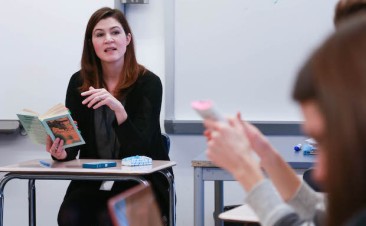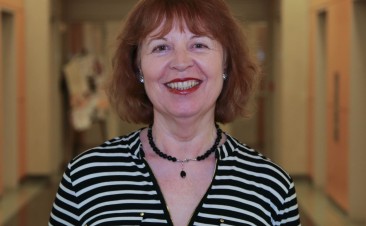Beginning in September, 2015, a dozen tenth grade students have been the pioneers of a bilingual pilot class. Two French and English literature teachers decided to adopt an original pedagogical approach by drawing on the language capabilities of their students and the linguistic and literary connections in their respective classes.
Called “2nde Lit-Litt” – a play on the words “littérature” and “literature”, this experimental class seeks to align the themes and concepts explored in the two classes in order to create bridges for the students in their learning while still adhering to the tenth grade curriculum for these two subjects.
The teachers are tackling such literary genres as satire, classical literature, tragedy, 19th century novels, 20th century essays and even poetry at the same time in their classes. For example, in March, the students studied 20th century American poets by writing about Paris in their English literature class, and French poets of the same period by writing about New York in their French literature class.
The idea for this pilot class emerged from research work on bilingual teaching strategies led by both teachers together during the summer of 2014 pursuant to a grant awarded by the LFNY. “We wanted to link our units together in order to create something more consistent”, explained Odile Sheehan, a teacher of French literature at the Lycée Français de New York since 2003. “This is a positive approach for our students on several levels such as analysis and comparison of texts”, added Margaret George, teacher of English literature who has been teaching at the middle school and high school levels at the LFNY since 2008.
“Even if bilinguals sometimes have difficulty expressing their ideas in a single language system, they possess analytical skills and a deeper understanding than monolinguals – that’s what the research shows and that’s also what we see in our classrooms”, explained Margaret George, English literature teacher at the Lycée Français de New York.
“We are studying books that have connections to one another in the two classes. It’s more interesting”, Guillaume, one of the students in the “2nde Lit-Litt” pilot class, pointed out. During the second trimester, in fact, the students studied tragedy in literature with Shakespeare’s Othello (in English) and Racine’s Britannicus (in French). “Instead of teaching specific works, certain movements or genres independently in English or in French, we wanted a course curriculum that would be coordinated and aligned between our two classes. Two syllabi combined in one syllabus”, summed up Ms. George.
To this end, the students are studying the theme of jealousy, a theme that is present in both Othello and Britannicus, and they are making comparisons between the two works. In Othello, jealousy is evoked by the “green-eyed monster”, though we also find this association between green and jealousy in French in the expression “to be green with jealousy”. “Allowing students to make this connection between the expressions in the two languages is going to help them remember, rather than learning them separately with an interval of six months”, observed Christine Hélot, researcher in the field at the University of Strasbourg and educational consultant at the LFNY for the 2015-2016 academic year.
But beyond the themes, the teachers are also bringing up the vocabulary of the structure of a play and the comparisons between the French work and the English work. For example, what we call the “expository scene” in French – the first scene – is translated in English as “opening scene”, but this does not cover exactly the same thing: the expository scene is thus a very important component of French plays.
“We have to accept that bilinguals think differently than monolinguals”, according to university specialist in multilingual education Christine Hélot.
“The teachers verbalize the relationships between the texts, the vocabulary and the concepts studied and that encourages students to do the same, to have a truly bilingual approach to their courses”, remarked university specialist Christine Hélot who had the opportunity to observe a10th grade Lit-Litt class. But which language do they speak in these classes?
Translanguaging
For Margaret George, English teacher, this is an important subject. “The parameters for their work must be clear: She emphasized that students cannot speak whichever language they want whenever they want”. Therefore, when comparing texts, they are allowed to cite the texts in their original language, but the analysis must be made in the language of the course. “During class discussions, I sometimes allow translanguaging”, the teacher explained, meaning use of the language of their choice, “but after the discussion, rephrasing in the language of the course is necessary in order to help all of the students express their ideas in the language of learning.”
Not prohibiting a language from a course is a better approach for a bilingual student population, according to specialist Christine Hélot: “Accepting the dominant language of the child allows him or her to be open to learn the other language, the one that is not as strong”, she explained. “We must accept that bilinguals do not think the same way monolinguals do: They are constantly going back and forth from one language to the other. They don’t think in each of the languages in isolation.”
Margaret George and Odile Sheehan teach class together regularly. One will come to the other’s class and vice versa. In that case, we are attending a class in which the students are navigating from English to French and are encouraged to express their ideas and to offer translations. “There are discussions during class; it’s very interactive”, one student emphasized. In this space where both languages are accepted, speech is freer: “Class participation is much better”, observed Odile Sheehan.
Emphasis on other skills
Students especially enjoy translation exercises, which are frequent in class. “We help each other: Those who are stronger in English speak more during a translation from French into English and vice versa”, indicated Zai, a student who admits she enjoys the experience. Class participation is a key indicator, according to Margaret George “because it is a sign that the students are mastering the texts.”
The teachers have succeeded in altering the class dynamic: Even though they guide and direct the students, they do not have all the answers. “In translation exercises, some students are much stronger in English than I am”, smiled Odile Sheehan, who added that “these exercises allow them to become aware of their bilingual skills which they do not always have the opportunity to show off.” The students appreciate having their teachers see them in a different light when they teach together. Students who remain silent in French, as a rule, express themselves more in English class and vice versa. Everyone realizes that there is no hierarchy between languages and that everyone is free to express himself or herself even if his or her language level is not as high as his or her neighbor’s. “We help each other and together, we make progress”, concluded one student.
Translated from French by Nicole Efros.
About the Author :
Former journalist, Cecile is passionate about multimedia storytelling. With her camera, notepad and microphone, she enjoys telling the great stories that are happening at the Lycée. Cecile was formerly senior communications manager at the school.



